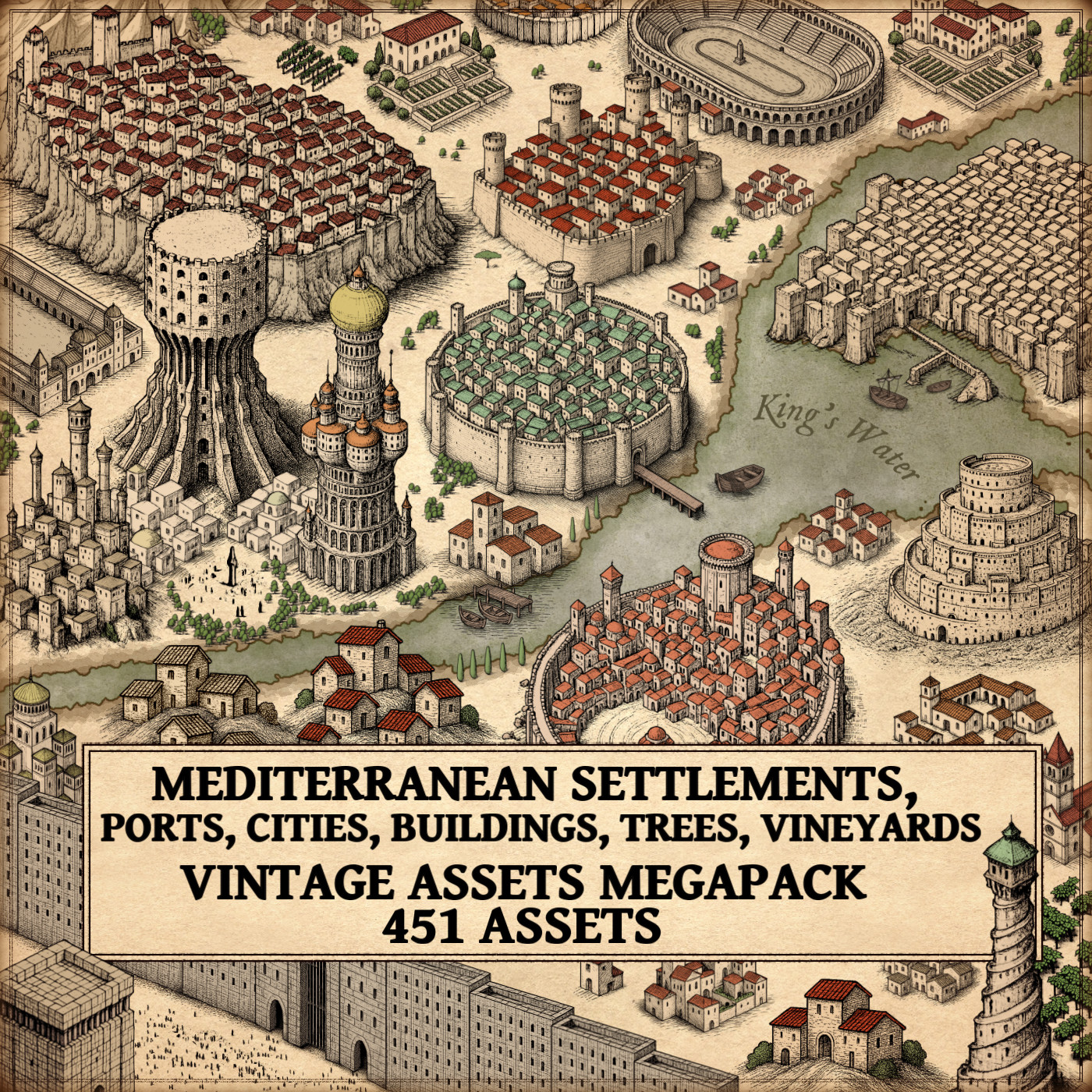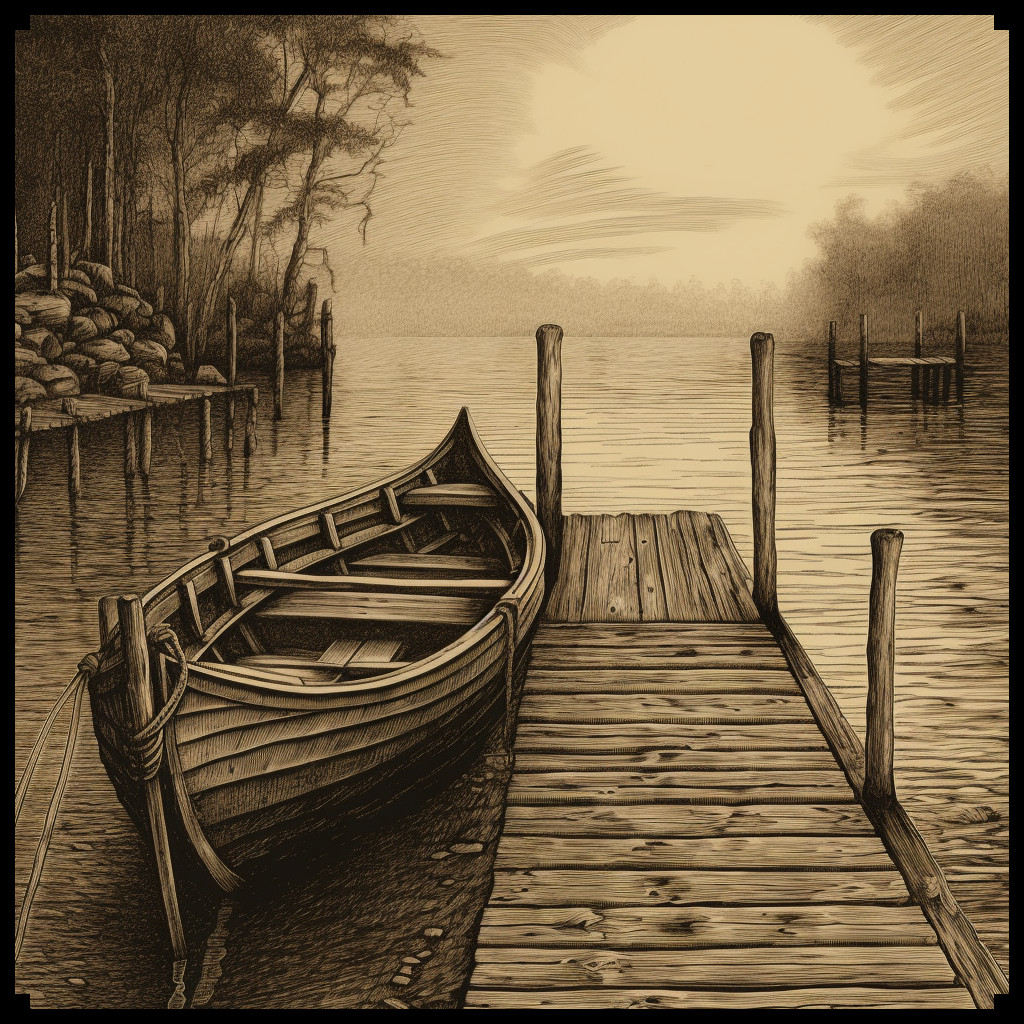
From medieval cartography assets in antique atlases to modern fantasy map icons used in roleplaying games, the Mediterranean world has always been represented through powerful imagery: walled cities on cliffs, busy harbors, Roman arenas, spiral towers, and vineyard-covered hills. These elements are not merely decorative—they are fantasy map symbols of culture, economy, and identity.
The Mediterranean Settlements, Ports, Cities, Villages, Vineyards, Buildings – Vintage Assets Megapack embraces this tradition. Designed as high-quality Wonderdraft assets, it provides mapmakers with an authentic visual language that echoes antique maps while serving modern fantasy cartography.
BUY AND DOWNLOAD The Mediterranean Settlements – Vintage Assets Megapack here :
Fortified Cities: Anchors of Power in Cartography Assets
Throughout history, fortified cities have been among the most prominent cartography assets. Medieval maps such as the Hereford Mappa Mundi (c. 1300) placed Jerusalem at the symbolic center, not for its geographic accuracy but for its cultural weight. Portolan charts of the Mediterranean also emphasized Genoa, Venice, and Constantinople as towering walled cities, dominating both sea and land.
In fantasy cartography, these fantasy map symbols instantly communicate strength, political intrigue, and cultural centrality. The Megapack’s fortified cities and towns, inspired by Tuscan citadels and Dalmatian fortresses, allow creators to anchor their maps with centers of history, trade, and storytelling.
Ports and Fishing Villages: Essential Fantasy Map Icons
Ports were the lifeblood of the Mediterranean. Ancient Roman itineraries recorded harbors meticulously, while Venetian cartographers exaggerated coastal cities to highlight maritime trade. Fishing villages—clusters of huts and small boats—appeared as humble yet vital symbols of subsistence.
The Megapack enriches maps with fantasy map icons of fishing villages, fortified ports, and fishing boats. These are indispensable cartography assets for campaigns set in worlds of piracy, commerce, and naval exploration. A single barque in a harbor can spark stories of smugglers, merchant guilds, or seaborne kingdoms.
Hilltop Villages and Mediterranean Settlements
The Mediterranean is famous for its hilltop villages, from the whitewashed towns of Andalusia to the fortified borghi of central Italy. Their elevation offered both protection and identity: villages as beacons above the land.
Historical cartographers like Piri Reis (16th century) often depicted settlements perched on stylized hills, emphasizing their dominance. The Megapack’s hilltop villages and hamlets bring this tradition to fantasy mapping, providing Wonderdraft assets that naturally blend geography with storytelling.
Roman Villas: Symbols of Aristocracy and Culture
Roman villas were more than luxurious estates—they were symbols of power, refinement, and connection to the land. Antique maps of Italy, as well as Renaissance engravings, often highlighted villas to showcase noble estates and agricultural wealth.
The Megapack includes elegant villa structures as fantasy map icons, evoking grandeur and continuity with the classical past. On fantasy maps, a villa may mark a patrician’s estate, a monastery, or the headquarters of a secret order. These cartography assets do not just place buildings—they evoke entire lifestyles.
Arenas and Hippodromes: Theaters of Spectacle
Among the most iconic monuments of the Mediterranean are the Roman arenas, amphitheaters, and hippodromes. Structures such as the Colosseum in Rome or the Hippodrome of Constantinople were more than entertainment venues: they were symbols of imperial authority, civic unity, and collective memory.
Antique maps and city views—such as Braun and Hogenberg’s Civitates Orbis Terrarum (1572)—often included these monumental arenas, placing them at the heart of their cities. They were not drawn to scale but to impress, to remind viewers of the spectacle and grandeur of urban life.
The Megapack brings these traditions into the fantasy realm with detailed Wonderdraft assets of amphitheaters and hippodromes. As fantasy map symbols, they suggest cultures of games, rituals, and political gatherings. A map marked with an arena is never neutral—it speaks of power, spectacle, and the stories of thousands who once gathered there.
Vineyards, Cypress Trees, and Stone Pines
Cultural landscapes were central to antique cartography. Cypress trees often symbolized sacred spaces, while stone pines, with their iconic umbrella canopies, became shorthand for the Mediterranean skyline. Vineyards, long associated with wealth and trade, were included in maps to highlight abundance and prosperity.
The Megapack’s inclusion of these elements allows cartographers to enrich their worlds with cultural depth. A vineyard marks agricultural wealth and trade routes. Cypress-lined avenues may signal cemeteries or temples. Stone pines add atmosphere, instantly evoking the sunlit coasts of Italy or Greece. These are more than decorative cartography assets—they are narrative markers of place and culture.
Arabic Villages: Mediterranean Crossroads
The Mediterranean was a crossroads of civilizations: Latin, Greek, Arab, Berber, and Jewish. Maps from the Islamic Golden Age, especially those of al-Idrisi (12th century), represented domed houses and cubic settlements that contrasted with European towns.
The Megapack reflects this with fantasy map icons of Arabic villages and towns. These cartography assets embody cultural diversity, encouraging fantasy creators to portray trade, migration, and cultural encounters. A domed village on a map is an invitation to explore stories of merchants, scholars, or desert pilgrims.
Minimalistic Crowds and Decorative Elements
Antique cartographers often populated maps with tiny figures: pilgrims, soldiers, merchants. These details animated maps, making them not just geographic but human. The Megapack’s minimalistic crowds follow this tradition, allowing mapmakers to breathe life into plazas, ports, and marketplaces with subtle fantasy map symbols.
Alongside spires, citadels, towers, and statues, these Wonderdraft assets transform maps into works of art, echoing the richness of antique cartography while serving modern worldbuilding.
Why These Fantasy Map Icons Matter
Maps have always been both functional and cultural. On one level, these cartography assets mark settlements, resources, and defenses. On another, they encode meaning: a fortified city signifies strength, an arena spectacle, a vineyard prosperity, a tower ambition.
In fantasy worlds, employing Wonderdraft assets like those in the Megapack places creators in the lineage of cartographers like Mercator or Piri Reis. Maps become more than guides—they become mirrors of civilizations and carriers of myth.
Conclusion: Antique Cartography Assets for Modern Fantasy Maps
The Mediterranean Settlements Megapack is more than a set of icons—it is a bridge between antique mapmaking and fantasy storytelling. With fortified cities, ports, fishing villages, Roman villas, arenas, hippodromes, vineyards, Arabic towns, and natural landscapes, it offers one of the most complete libraries of fantasy map icons and fantasy map symbols available.
For creators seeking high-quality Wonderdraft assets or historically inspired cartography assets, this collection ensures that every map is not only functional but a work of art, rich with history, culture, and narrative potential.


